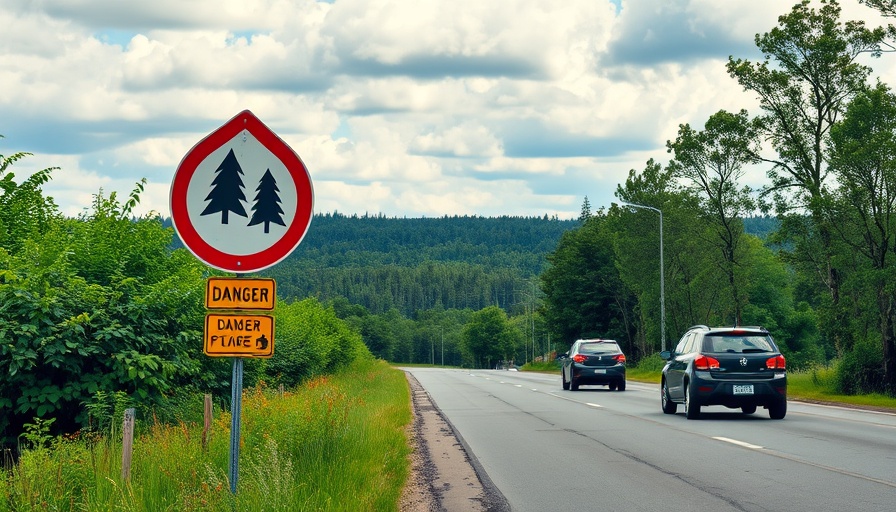
Wildfires in B.C.: The Summer of Smoldering Embers
Recent reports indicate a troubling resurgence of holdover wildfires in British Columbia, particularly near Fort Nelson. The situation is aggravated by an unseasonably warm and dry weather pattern, which has breathed life into fires that have been smoldering since last year. These holdover fires, although dormant, are now visibly smoking and require vigilant monitoring and immediate action from emergency services.
What's Causing the Renewed Activity?
The B.C. Wildfire Service notes that these wildfires were previously buried underground but have come alive with increasing temperatures and dry conditions. Officials are particularly concerned about the potential risks these fires pose to critical infrastructure in the area. With resources from across the province mobilized to address hotspots, safety is the primary focus.
The Bigger Picture: Climate Change Impacts on Wildfires
This resurgence highlights the ongoing challenge of climate change, which has been a significant factor in the frequency and intensity of wildfires in Canada. Warmer temperatures and drier seasons have become more common in British Columbia, leading to longer fire seasons and conditions ripe for wildfires. Environmental scientists warn that unless CO2 emissions are reduced, regions like B.C. could face even more severe wildfire seasons in future years, raising concerns for community safety and ecological preservation.
A Community Under Threat
Residents near Fort Nelson are not just dealing with the psychological strain of living under the shadow of wildfires; they are also facing potential evacuation orders and disruptions to their daily lives. The wildfire service has been proactive, deploying crews to monitor and tackle the most hazardous blazes while maintaining safety protocols to protect both personnel and communities. This collective effort shows the community's resilience in the face of nature's fury, but it also raises questions about long-term preparedness.
Understanding Fire Behavior: Hidden Risks
Holdover wildfires can often behave unpredictably, resurfacing with little warning due to the right combination of temperature, moisture, and wind conditions. For those unaware, these smoldering fires can reignite, leading to rapid spread and uncontrollable hot spots. Firefighters emphasize that understanding the dynamics of these holdover fires is crucial in mobilizing effective responses. Regular communication between residents and wildfire management agencies is essential to ensure that appropriate measures are taken as the season progresses.
Tools and Techniques for Fire Management
The B.C. Wildfire Service has been implementing a variety of tools and techniques to monitor and combat these holdover wildfires. These include aerial reconnaissance, ground patrols, and advanced fire simulation modeling to predict fire behavior. Resources such as drones equipped with thermal imaging help identify hot spots that may not be visible to the naked eye, allowing fire crews to prioritize their firefighting efforts effectively.
Hope for Future Fire Seasons
Despite the pressing concerns surrounding current wildfires, there is hope for innovative solutions to reduce their frequency and intensity in the future. The province is exploring various strategies, including investing in enhanced fire prevention resources and improving community resilience through effective emergency management and awareness training. As we learn more about wildfire ecology, there may be pathways toward restoring balance in ecosystems affected by fire, potentially mitigating the impact of future wildfires.
Your Role in Fire Prevention and Safety
As a community member, understanding your surroundings and making informed decisions about fire safety can help protect not just your home and family but also your neighbors. Share knowledge regarding safe burning practices, participate in community fire prevention programs, and stay informed through local wildfire updates to become an active participant in preventing future fire disasters.
Recognizing the interconnectedness of our environments and actions is crucial. Learn how you can contribute to sustainability efforts in your area, advocate for responsible land management, and support local initiatives focused on wildfire prevention and education.
As the summer unfolds and temperatures rise, staying informed and prepared is paramount. Your engagement can make a difference in safeguarding communities from the ravages of wildfires.
 Add Row
Add Row  Add
Add 




 Add Row
Add Row  Add
Add 

Write A Comment